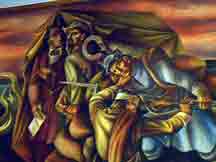
The Men Who Started the Shooting War |

The Men Who Started the Shooting War |
The Battle of Wilson's Creek |
The general belief may be that the Civil War began in April of 1861 when scrappy little General Pierre Gustave Toutant Beauregard fired on Fort Sumter in Charleston Harbor. For Missouri, that’s not the half of it--literally. We started fighting seven years earlier--with the Kansas-Nebraska bill of May 30, 1854. This “Popular Sovereignty” act allowed territories to choose slavery or ban it.
I wonder whether the bill’s sponsor--the little giant from Illinois--Stephen A. Douglas--knew what forces he was unleashing. Both sides rushed people into Kansas to further their own agendas.
Border Ruffian Missourians made our western neighbor bleed. In the election of March 30, 1855, more than six thousand voted. How many people actually lived in Kansas? 2905.
In Lawrence, hotbed of anti-slavery and adopted home of fiery abolitionist John Brown, the vote was 781 for the PRO-SLAVERY candidate and only 253 for the free-stater. How could such an upset happen? A thousand Missouri men arrived in the town the day before the election. Their first act was to try to bribe a poll judge. When that didn’t work, they threatened to hang him. Reasonably enough, he left town--and a pro-slavery judge took his place.
The Missourians actually paraded their intent by wearing white ribbons. They refused to take the required oath to swear they planned to make Kansas their home. One said that a man who’d been in Kansas an hour deserved to vote.
Genuine residents without ribbons were driven from the polls. Only one anti-slavery man was elected in the whole territory.
The new legislature met in July and ousted all anti-slavery men. They moved the territorial capital from Pawnee to Shawnee Mission--just across the state line from Missouri. They even made so bold as to declare speaking out against slavery a punishable offense. They petitioned President Pierce to Remove Governor Reeder who objected to all these doings. Pierce sent in a pro slavery man to govern the territory.
Free staters would not be silenced. They set up their own unrecognized government in July of 1855. May 21, 1856, eight hundred Missourians raided Lawrence, Kansas. May 24, 1856, John Brown’s abolitionists killed five pro-slavers at Pottawatomie. The two factions turned Kansas into a war zone. Across the country, anti-slavery rallies built floats with thirty-one girls in white representing the states--and one in black to represent bleeding Kansas.
Perhaps the saddest of all came with the Supreme Court’s decision in the Dred Scott case in 1857. The court struck down the Kansas Nebraska Bill. The justices thought to settle the slavery issue once and for all by making slavery legal everywhere. What they accomplished was to pour gasoline on a brushfire. It would rage out of control and create untold havoc.
Click Lincoln and Douglas
to see the next part of
"What Caused the Civil War?" by Donna Ross.